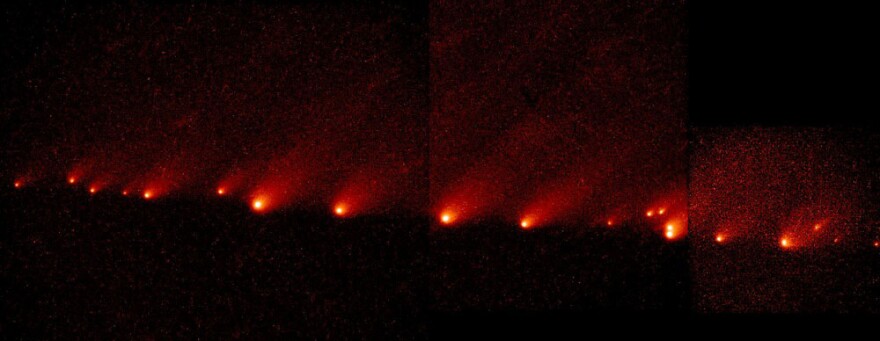The astronomy community has lost a pioneer. Famed Flagstaff astronomer Carolyn Shoemaker passed away Friday at the age of ninety-two. She discovered more than thirty comets in her lifetime, and blazed a path for women in the sciences. KNAU’s Melissa Sevigny spoke with her in 2017 about her unconventional journey into astronomy, and brings us this remembrance.
She was born Carolyn Spellmann in 1929 and grew up in Chico, California, a farm girl in orchard country.

"I wasn’t interested in space at that time," she said. "I didn’t know anything about space." Her mother suggested she become a teacher. She did that for one year. She hated it, "and decided I didn’t really want to teach anymore, and luckily for me, I didn’t have to, because by that time I had met Gene Shoemaker."
Gene was a geologist obsessed with the idea of going to the moon. The two fell in love through letters and married in 1951. Eventually they moved to Flagstaff and raised three children. It was a place where Shoemaker could do what she loved: long drives and camping trips in wild country and river rafting adventures. When the Space Race began, the Shoemakers hosted astronauts in their home.
Around 1980, Shoemaker said to her husband: “Gene, you’re doing exactly what you want all the time and having a marvelous time about it. Have you any suggestions for me, as to what I can do, now that our children have left home?” They were splitting their time between Flagstaff and Pasadena, where Gene had started a first of its kind program at Palomar Observatory, hunting for asteroids that veered close to Earth. "Gene suggested that possibly I would be interested in working on that," Shoemaker remembered. "And I thought, I don’t think so, I’ve never stayed awake at night in my life!"
But she started spending time in the deepest basement at the California Institute of Technology, searching through photographs of the night sky made on glass plates. It was her job to find asteroids that appeared as tiny specks which “blinked” or moved quickly from one frame to the next. She was good at it.
"I could look at those plates and you know, that was the sky," she said. "I didn’t feel like I was down in the basement, I was looking at the sky."
In 1983 she discovered her first comet. "It was a really exciting, thrilling experience, because I didn’t think I would ever find a comet," she said. She went on to find 32 of them. At one time she held the record for the most comets ever discovered by one person.
Her most famous finding happened in 1993, on an unpromising stormy night. "It was snowing outside," she said. "But I was scanning the film, and then I came across this fuzzy object." It was like no comet she had ever seen before. It had been torn into pieces, and the fragments were screaming down toward the surface of Jupiter. The news shocked and thrilled the world. But Shoemaker recalled with a laugh: "I was dismayed. I was going to lose a comet, and I’d never lost one. I was going to lose a number of them!"

Few scientists at the time believed comet and meteorite impacts played a meaningful role in the solar system’s history. The Shoemakers changed that. They studied impact craters all over the Earth, including the outback of Australia. It was there, in 1997, that Gene was killed in a head-on-collision. In honor of his long dream, NASA sent his ashes to the moon.

Shoemaker continued her work in Flagstaff with ties to Lowell Observatory, Northern Arizona University, and the U.S. Geological Survey. Her life was full of desert rivers and wide-open spaces. But it was the night sky that opened her world into what she described as magic.
"I could sit there guiding on a star with the telescope, and look out the slit, and I was just in awe, because that was the universe up there. You know, I just—it was magical for me, all of a sudden."
Carolyn Shoemaker may have come late to the study of astronomy but she left a blazing trail for others to follow.







